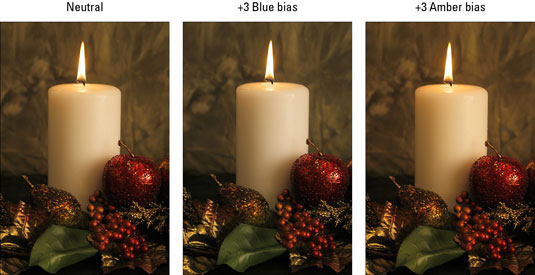You can take advantage of the automatic White Balance Bracketing capabilities of the Canon EOS 60D. With this feature, the camera records the same image three times, using a slightly different white balance adjustment for each one.
This feature is especially helpful when you’re shooting in varying light sources: for example, a mix of fluorescent light, daylight, and flash. Bracketing the shots increases the odds that the color renditions of at least one of the shots will be to your liking.
Note a couple of things about this feature:
Because the camera records three images each time you press the shutter button, using white balance bracketing reduces the maximum capture speed that’s possible when you use the Continuous shooting mode. Of course, recording three images instead of one also eats up more space on your memory card.
The White Balance Bracketing feature is designed around the same grid used for White Balance Correction. As a reminder, the grid is based on two color pairs: green/magenta and blue/amber.
When White Balance Bracketing is enabled, the camera always records the first of the three bracketed shots using a neutral white balance setting — or, at least, what it considers to be neutral, given its own measurement of the light. The second and third shots are then recorded using the specified shift along either the green/magenta or blue/amber axis of the color grid.
These images were shot using a single tungsten studio light and the candlelight. White Balance Bracketing was set to work along the blue/amber color axis. The camera recorded the first image at neutral, the second with a slightly blue color bias, and the third with an amber bias.

To enable White Balance Bracketing, follow these steps:
Set the Mode dial to a mode in the Creative Zone (P, Tv, Av, M, B, or C).
Display Shooting Menu 2 and highlight WB/Shift Bkt.
Press Set.

Rotate the Quick Control dial to set the amount and direction of the bracketing shift.
Rotate the dial as follows to specify whether you want the bracketing to be applied across the horizontal axis (blue to amber) or the vertical axis (green to magenta).
Blue to amber bracketing: Rotate the dial right.
Green to magenta bracketing: Rotate the dial left.
As you rotate the dial, three markers appear on the grid, indicating the amount of shift that will be applied to your trio of bracketed images. You can apply a maximum shift of plus or minus three levels of adjustment.
The Bracket area of the screen also indicates the shift. As you can see, even at the maximum shift (+/- 3), the difference to the colors is subtle.
If you want to get truly fancy, you can combine White Balance Bracketing with White Balance Shift. To set the amount of White Balance Shift, press the cross keys to move the square markers around the grid. Then use the Main dial to adjust the bracketing setting.
Press Set to apply your changes and return to the menu.
The bracketing symbol appears in the Shooting Settings display. The Camera Settings display, which you bring up by pressing Info when any menu is visible, also reports the bracketing setting.

The bracketing setting remains in effect until you turn off the camera. You can also cancel bracketing by revisiting the grid screen and either rotating the Main dial until you see only a single grid marker or pressing the Info button. Either way, press Set to officially turn off bracketing.






